About this Orbit: From Ballet to Broadway and Black

For a lot of Black dancers in the 20th century, opportunities were few and far between as companies and choreographers would not work with Black dancers. There were some companies that were open to Black dancers but a lot of them would close a few years after opening leaving those company members without places to dance. Although receiving training at schools like the Doris Jones-Clara Haywood School of Dance and School of American Ballet, the dancing scene in New York was tough.
A place of more opportunity for Black dancers was Broadway. Broadway offered another way for ballet dancers to perform and continue training while not in a strictly ballet company. This avenue provided dancers like Arthur Mitchell, Louis Johnson, Helen Taitt, and Talley Beatty more ways to dance and enhance their craft. This orbit focuses on four Broadway shows and one performed at Jacob’s Pillow from the 20th century, Lew Leslie’s Blackbirds of 1939, Four Saints in Three Acts (1952), House of Flowers, Billy Wilson’s Guys and Dolls, and The Road of the Phoebe Snow, which provided more opportunities for Black dancers to dance when they could not find others.
Sources:
Four Saints in Three Acts Broadway Revival, Playbill
House of Flowers, Playbill
Lew Leslie’s Blackbirds of 1939, Playbill
“Dance of the African Diaspora: Talley Beatty” by John Perpener, Jacob’s Pillow Dance Interactive

Lew Leslie’s Blackbirds of 1939
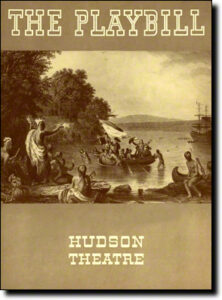
Lew Leslie’s Blackbirds of 1939 was the last musical review in his series of all-black Blackbirds productions. Leslie was commonly known as “Black Ziegfeld”, despite being white, because his shows featured Black performers and gave them a platform that they did not ordinarily have. Starting from its debut on February 11, 1939 to its closing on February 18, 1939, Blackbird’s of 1939 ran for 9 performances at the Hudson Theater of New York City and it was designed and supervised by Mabel A. Buell. Blackbirds of 1939 featured the Von Grona Negro Swing Ballet which was comprised of prominent Black ballet dancers and led by Eugene Van Grona, the founder of the American Negro Ballet.
Blackbirds of 1939 is a musical that takes inspiration from vaudeville. The show has 2 acts which are each comprised of a series of musical and dance performances. Act 1 has 12 segments and introduces Von Grona’s Negro Swing Ballet, featuring Beryl Clark and Al Bledger, in Children of the Earth. Act 2 has 9 segments, including the finale, and features the J. Rosamond Johnson Choir in addition to Von Grona’s Swing Ballet.
Dancers: Marion Brown, Dorothy Jones, Evelyn Pilcher, Edith Ross, Hazel Spence, Lavinia Williams, Alfred (Al) Bledger, Edith Hurd, Muriel Cook, and Coleman Hill
Sources:
Blackbirds of 1939, Playbill
Blackbirds of 1939, Jazz Standards
Von Grona’s Swing Ballet
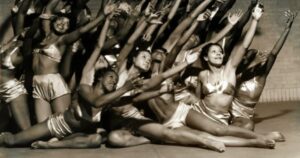
Eugene Von Grona trained in dance in Germany and arrived in New York City in 1928 with Mary Wigman. He formed the American Negro Ballet in 1934 after seeing the zeal of the artists working in Harlem, noting the new type of dance energy he saw in them that was lacking in European dancers. He thought that the dancers he found for his company “didn’t have the opportunity” for technique classes and so he gave it to them at the American Negro Ballet. ANB was the first professional company to feature concert dance with Black members on a scale that garnered acceptance from the media as well as criticism.
They used the term “ballet” to describe all the dance they were doing, though not a classical ballet company. In 1939, members of the company performed alongside the New York Negro Symphony Orchestra; these members were Valerie Cavell, Marion Brown, Beryl Clarke, Viola Gibson, Dorothy Jones, Harriet Oliver, Evelyn Pilcher, Edith Ross, Pearl Spears, Hazel Spence, Ettie Stephens, Willard Taylor, Elizabeth Thompson, Lavinia Williams, Wahneta Talley, Teddy Allen, Alfred Bledger, Jon Edward, Anthony Fleming, Frank Green, Coleman Hill, James Smith, and Harry Young.
Sources:
“Which was the first?” A historical essay on the first Black Dance Company in the USA
Four Saints in Three Acts (1952)
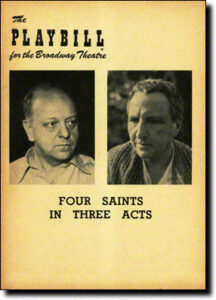
The reprisal of Four Saints in Three Acts in 1952 had 15 performances from April 16, 1952 – April 27, 1952 at the Broadway Theatre in New York, NY. Virgil Thomson (artistic and musical direction), Gertrude Stein (libretto), Maurice Grosser (director), and Florine Stettheimer (design) were all involved in the reprisal as well as the original production in 1934. Choreography by William Dollar, directed by Maurice Grosser, scenic and costume design was done by Paul Morrison, and the show was produced by The American National Theatre and Academy and in association with Ethel Reiner. The dancers in the show were Arthur Mitchell, Louis Johnson, Helen Taitt, and Mabel Hart who was dancing in the show again after her appearance in the 1934 production.
Four Saints in Three Acts is an opera that starts with a prelude from the chorus. The first act takes places at Ávila cathedral titled “St. Teresa half indoors and half out of doors.” Act two, entitled “Might it be mountains if it were not Barcelona,” has a telescope and glimpses of a heavenly mansion. Act three, “St. Ignatius and one of two literally,” involved a picnic and had Ignatius’s aria “Pigeons on the grass alas.” Act three ends with a tango-like ballet, followed by the fourth act, “The sisters and saints reassembled and re-enacting why they went away to stay,” which is set at the garden of a monastery.
Dancers: Arthur Mitchell, Louis Johnson, Helen Taitt, and Mabel Hart
Sources:
Four Saints in Three Acts Revival, Playbill
Four Saints in Three Acts, Wikipedia
House of Flowers
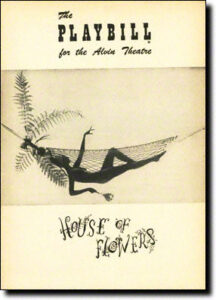
With over 165 performances in the span of a year, “House of Flowers” originated in 1954 and was based on Truman Capote’s short story of the same name. Set in the West Indies, this musical is about two bordellos and a love story that ensues between one of the brothel’s girls and a poor boy named Royal.
The show featured performers like Carmen de Lavallade, Geoffrey Holder, and Louis Johnson, with music by Harold Arlen, and lyrics by Arlen and Capote.
Directed by Peter Brook, choreographed by Herbert Ross, and produced by Saint Subber, “House of Flowers” was staged at the Alvin Theater in New York City.
Dancers: Carmen de Lavallade, Geoffrey Holder, Louis Johnson, Arthur Mitchell, and Glory Van Scott
Sources:
Billy Wilson’s Guys and Dolls
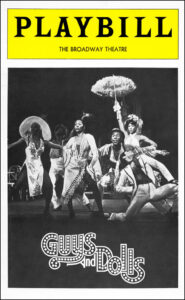
Billy Wilson, famed director and choreographer who spent most of his career with the Dutch National Ballet wanted to create a Black version of Frank Loesser’s Broadway show Guys and Dolls in 1976. In an interview with The New York Times, Wilson described the adaptation of the classic: “it was like taking chicken soup,” he said, a slow smile crossing his face, “and making it a little more gumbo.” Wilson said he first got the idea to do a black version of “Guys and Dolls” [in 1972], after he staged white production of the show at Brandeis University, where he was then head of the dance program. He continued: “I thought there were many things in it that translate to the black experience,” he said. “For example, the Save A Soul Mission that Sister Sarah runs, which is close to our storefront churches and evangelistic things, and the gambling and the showgirls, which are very much a part of the black experience. Updated and given a bit of juice and soul, I thought it would be great—and fun. So when Moe Septee, one of the producers cf ‘Bubbling Brown Sugar,’ spoke with me about what I wanted to do next, I said ‘Guys and Dolls.’”
Cast/Dancers: Norma Donaldson, Robert Guillame, Ernestine Jackson, James Randolph, Edye Byrde, Clark Morgan, Ken Page, Christophe Pierre, Emett “Babe” Wallace, Derrick Bell, Toney Brealond, Jymie Charles, Bardell Conner, Prudence Darby, Irene Datcher, Alvin Davis, Jacquelyn DuBois, Anna Maria Fowlkes, Helen Gelzer, Nathan Jennings, Jr., Julia Lema, Bill Mackey, Sterling McQueen, Marion Moore, John Russell, Jacqueline Smith-Lee, Freda T. Vanterpool, Walter White, Eddie Wright, Jr., and Andy Torres
Sources:
‘Guys and Dolls’ Comes Back, The New York Times
Guys and Dolls Revival, Playbill
The Road of the Phoebe Snow

The Road of the Phoebe Snow was a show put on by Jacob’s Pillow in August of 1960. The show ran for 4 days from August 2nd to August 6th. There were 5 shows in the evening (running from Tuesday to Saturday) and two matinées (Friday and Saturday).
The plot of the show is inspired by a famous train called ‘The Phoebe Snow.’ A train that used to travel the Lackawanna Railroad Line, it has a deep history and narrative attached to it. The show itself explores the stories of this train and what may have happened on or near the railroad itself.
Though the show was hosted at Jacob’s Pillow, it is included in the orbit because the main cast is made up of notable Black Broadway performers including Charles Moore, Georgia Collins, Talley Beatty, and finally Candace Caldwell. It was also choreographed by Talley Beatty. This is indicative of code-switching that Black ballet dancers had to engage in just to be able to perform. They performed whenever they could and in whatever role was available to them. To this extent, this performance of The Road of the Phoebe Snow also demonstrates how supportive the Black dancer community was of each other and how through the connections they had to each other, each was able to succeed.
Dancers: Charles Moore, Georgia Collins, Talley Beatty, and Candace Caldwell
Sources:
The Road of the Phoebe Snow, Alvin Ailey American Dance Theater
Beatty’s ‘Road of Phoebe Snow’ Is Still Jarring Dance Audiences, The New York Times
Dance: Beatty’s Ghetto, The New York Times
Valerie Bettis; Robert Cohan and Matt Turney; Talley Beatty & Company [Program-239], Jacobs Pillow Archive
The Road of The Phoebe Snow, Jacobs Pillow Archive
Patsy Gay, Jacob’s Pillow
Jacob’s Pillow

The site of Jacob’s Pillow in Becket, Massachusetts was originally settled in 1790 by Jacob Carter III. Because of the zigzagging road leading to the hilltop property, it became known as “Jacob’s Ladder”, after the Biblical story, and a pillow-shaped rock on the property prompted the farm to acquire the name “Jacob’s Pillow”. The farm was purchased in 1931 by modern dance pioneer Ted Shawn as a dance retreat. Shawn and his wife, Ruth St. Denis, led the highly regarded Denishawn Company, which had popularized dance forms rooted in theater and cultural traditions outside European ballet. They were influential in training a host of dance pioneers, including Martha Graham, Charles Weidman, Doris Humphrey, and Jack Cole.
The Road of the Phoebe Snow was a show put on by Jacob’s Pillow in August of 1960. The show ran for 4 days from August 2nd to August 6th. There were 5 shows in the evening (running from Tuesday to Saturday) and two matinées (Friday and Saturday).
 Nicole Toney, Morinsola Tinubu, Nhi Phan, and Sana Jawa
Nicole Toney, Morinsola Tinubu, Nhi Phan, and Sana Jawa

